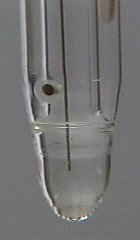Combination electrode
Combination
electrode
Glass electrode
Indicator electrode
Measuring electrode
Reference electrode
Combination electrode
Combination of a reference electrode and an indicator electrode into a single probe. The Glass electrode are commonly available as combination electrode.
An electrode whose potential is proportional to the pH of the solution into which it is dipped.
It is made up of a glass ball (diameter less than 1 cm and thickness about a hundredth of mm) filled with a buffer solution of known pH (generally pH = 7) into which an internal electrode reference (generally AgCl / Ag in saturated KCl) is placed.
Commonly, the glass electrode is associated with a reference electrode and thus constitute a so-called "Combination electrode".
Indicator electrode
/ measuring electrode
An electrode which, when placed in a solution, measures the activity or concentration of a given ion.

It can be used in conjunction with a reference electrode for potentiometric titrations.
An electrode which has a constant and perfectly reproducible potential whatever the medium into which it is placed.
The standard reference electrode is the hydrogen electrode, which is based on the H3O+ / H2 couple.
As the hydrogen electrode is difficult to handle reproducibly, other reference electrodes are used. Most commonly these employ the calomel/mercury, mercurous sulphate/mercury, silver chloride/silver couples.
Such electrodes are used together with an indicating or measuring electrode, for potentiometric titrations.